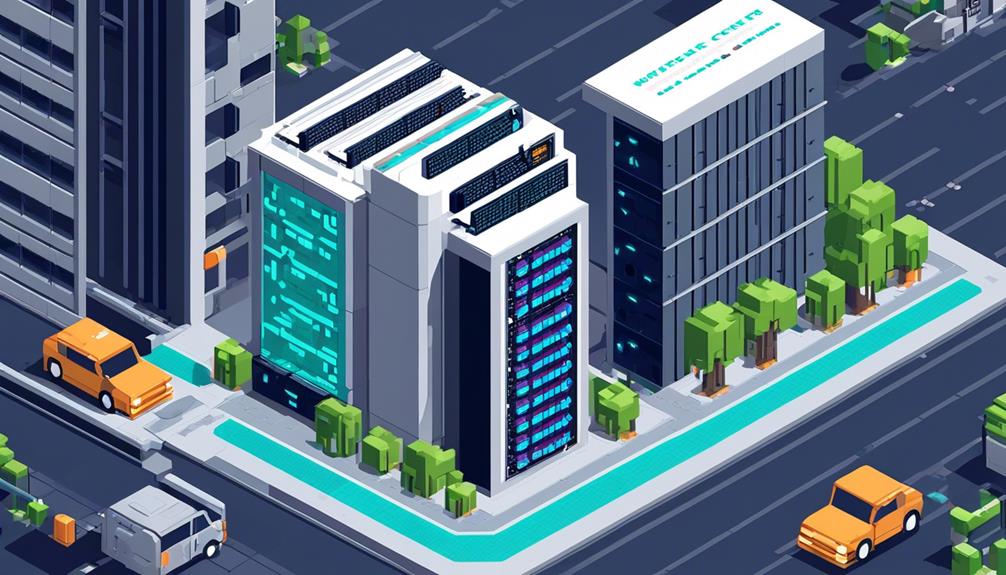As edge computing continues to gain momentum, the role of micro data centers becomes increasingly significant in enabling efficient and timely data processing. These compact data centers bring computing resources closer to the point of data generation, thereby reducing latency and improving response time.
The benefits of micro data centers extend beyond just speed and performance improvements. They also address the challenges posed by the growing influx of machine-generated data from IoT and 5G devices. By caching data at the edge, micro data centers minimize the need for reliance on larger, centralized data centers, resulting in cost savings and enhanced overall system performance.
In industries ranging from energy and manufacturing to retail, healthcare, and transportation, the synergy between edge computing and micro data centers becomes vital for real-time data processing and overcoming bandwidth and latency limitations.
With the groundwork laid, it is crucial to delve further into the specifics of edge computing, exploring the benefits, hardware requirements, security considerations, scalability, and flexibility, as well as the application of micro data centers in various industries.
By understanding these aspects, we can gain insights into the future trends and emerging opportunities in micro data centers for edge computing.
Key Takeaways
- Edge computing enables data processing closer to its source, reducing latency.
- Micro data centers handle real-time data generated by devices and sensors, eliminating the need to transmit all data to a centralized data center.
- Micro data centers reduce latency and increase data security by keeping sensitive data on-site and minimizing risks during transmission.
- Micro data centers contribute to business continuity while addressing security concerns and enhance overall network performance and protect valuable data.
Edge Computing Basics
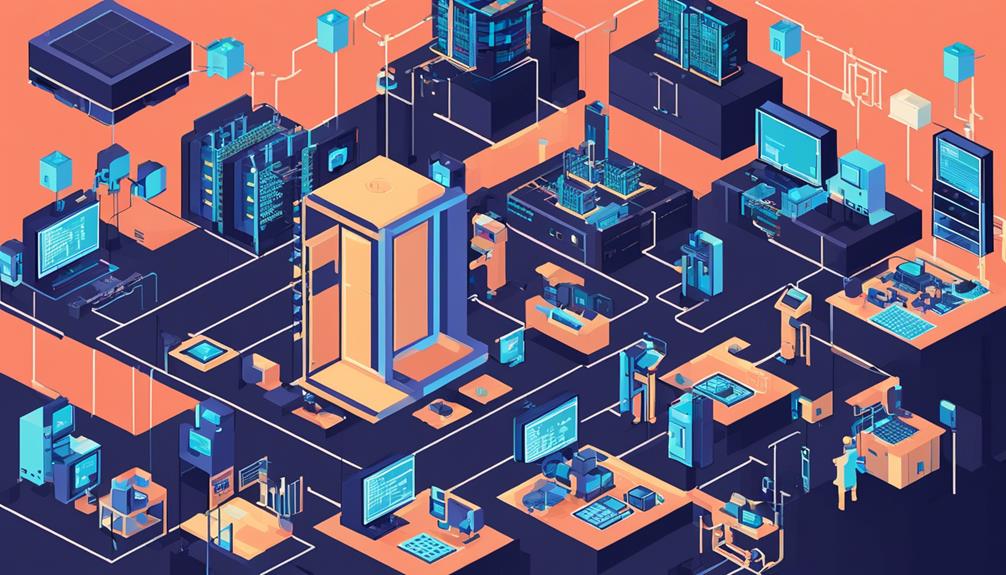
Edge computing is a distributed architecture that enables data processing to occur closer to its source, improving efficiency and reducing latency. It involves the deployment of micro data centers, which are smaller-scale versions of traditional data centers, at the edge of the network. These micro data centers act as processing points that handle real-time data generated by various devices and sensors.
With edge computing, data processing is performed closer to where it is generated, eliminating the need to transmit all data to a centralized data center or cloud for processing. This reduces latency and ensures faster response times, making it ideal for applications that require real-time data analysis and decision-making. By bringing processing resources closer to the source, edge computing also reduces the amount of data that needs to be transmitted, resulting in improved network efficiency.
Micro data centers play a crucial role in enabling edge computing. They are designed to be compact, modular, and scalable, allowing organizations to deploy them in various locations depending on their specific needs. These micro data centers house the necessary computing, storage, and networking resources required for processing data at the edge. They are equipped with high-performance processors, solid-state drives, and reliable networking infrastructure to ensure efficient data processing and transmission.
Furthermore, edge computing enhances security by reducing the chances of data compromise. With a distributed architecture, sensitive data can be processed locally without being transmitted over long distances, minimizing the risk of interception or unauthorized access. Organizations can implement security measures and protocols at the edge, ensuring the integrity and confidentiality of their data.
Benefits of Micro Data Centers
Micro data centers offer several benefits in edge computing.
Firstly, they can reduce latency and increase data security. By bringing the computational power closer to the edge devices, micro data centers enable faster processing and response times. This minimizes the delay between data generation and analysis, improving overall performance.
Moreover, micro data centers can enhance data security. By keeping sensitive data on-site, these data centers reduce the risks associated with transmitting information to a centralized location. This helps to protect valuable data and ensure its integrity.
Reduced Latency Advantages
The reduced latency advantages offered by micro data centers contribute to faster response times for data processing, enhancing overall network performance. Here are three key ways in which micro data centers achieve reduced latency:
- Proximity to the user: Micro data centers bring data closer to the user, reducing the need to connect to larger, centralized facilities. This proximity results in shorter network paths and faster data transmission.
- Data caching: Micro data centers employ data caching techniques, storing frequently accessed data locally. By reducing the need to transmit data to larger data centers for processing tasks, latency is significantly reduced.
- Edge processing: With micro data centers located at the edge of the network, processing tasks can be performed closer to the source of data. This eliminates the latency associated with sending data to centralized data centers, enabling faster response times.
Increased Data Security
One of the significant benefits of incorporating micro data centers in edge computing is the increased data security they provide.
Micro data centers enable a distributed architecture, reducing the chances of compromise and enhancing security measures.
With data being processed closer to the end-user, there is a reduced need for transmitting data across networks, resulting in lower bandwidth costs and minimizing the risk of data breaches during transmission.
Furthermore, micro data centers allow for isolating compromised areas without shutting down the entire operation, ensuring business continuity while addressing security concerns.
The combination of edge computing and micro data centers provides proximity, enabling faster performance and lower latency, thereby enhancing data security.
Hardware Requirements for Edge Computing
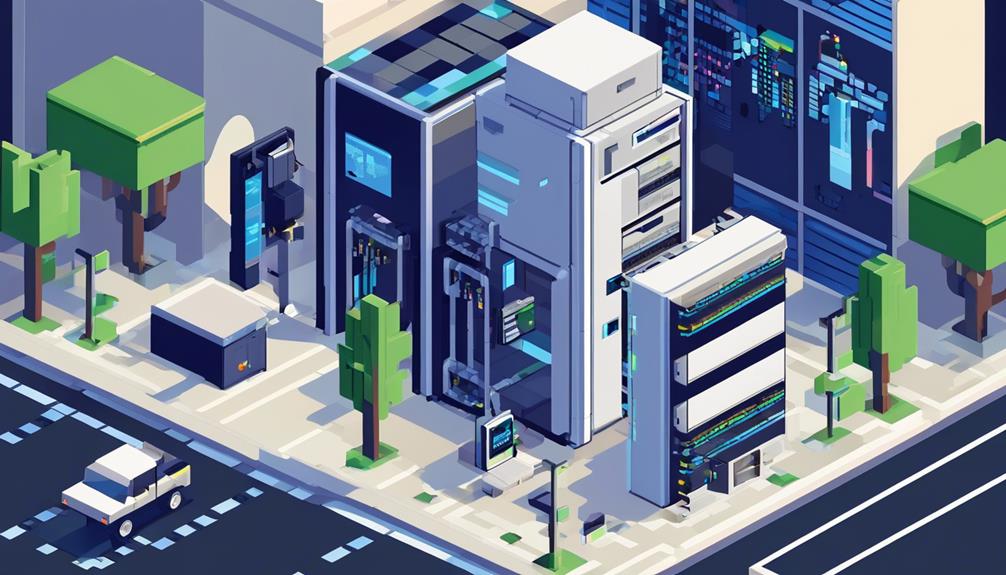
To support processing closer to the data source, edge computing requires specific hardware configurations that are compact, energy-efficient, and capable of withstanding harsh environments. Micro data center solutions are designed to meet these requirements, providing a compact and ruggedized infrastructure for edge computing deployments.
Here are three key hardware requirements for edge computing:
- Processing Power: Edge computing requires hardware with sufficient processing power to handle real-time data processing and analysis. This is crucial for applications that rely on low latency and near-instantaneous decision-making. High-performance processors and GPUs are often used to enable fast and efficient data processing at the edge.
- Bandwidth Limitation: As edge computing involves processing data closer to the source, there may be limitations on available network bandwidth. To address this, edge hardware should have the ability to locally cache and process data, reducing the need for constant communication with the central data center. This helps to minimize latency and optimize network bandwidth usage.
- Data Center Design: Since edge computing deployments are often located in remote or harsh environments, the hardware should be designed to withstand these conditions. This includes features such as ruggedized enclosures, dust and moisture resistance, and temperature control mechanisms. Additionally, the hardware should be easily deployable and remotely manageable to support the scalability and agility required for edge computing.
Role of Micro Data Centers in Edge Security
With its ability to enable data processing closer to the source, micro data centers play a crucial role in enhancing edge security by minimizing the transmission of sensitive data across networks. In edge computing, where data is processed at or near the edge of the network, micro data centers serve as local hubs for data storage and processing. Unlike centralized data centers, which typically house large volumes of data, micro data centers are smaller in size and can be deployed in remote locations, closer to where the data is generated.
One of the key advantages of edge computing through micro data centers is the reduction of latency issues that may affect the efficient functioning of some applications in cloud environments. By processing data locally, rather than sending it to a centralized data center, edge computing minimizes the time it takes for data to travel back and forth between the source and the processing center. This not only improves the overall performance of applications but also reduces the risk of data breaches or unauthorized access during data transmission over networks.
Furthermore, the use of edge computing and micro data centers can mitigate the impact of unstable network connections in remote locations. In industries with remote retail store locations, for example, micro data centers ensure business continuity and a great customer experience by enabling local data processing and storage. This approach reduces reliance on stable network connections and ensures that operations can continue even in the event of network disruptions.
In addition to these benefits, micro data centers also support the growing demand for collaboration and work process reimagining in edge computing. As organizations integrate 5G technology and explore new ways of leveraging edge computing, micro data centers become essential in providing the necessary infrastructure to support these efforts. By enabling secure data processing at the edge, micro data centers play a vital role in ensuring edge security and protecting sensitive information from potential threats.
Scalability and Flexibility of Micro Data Centers
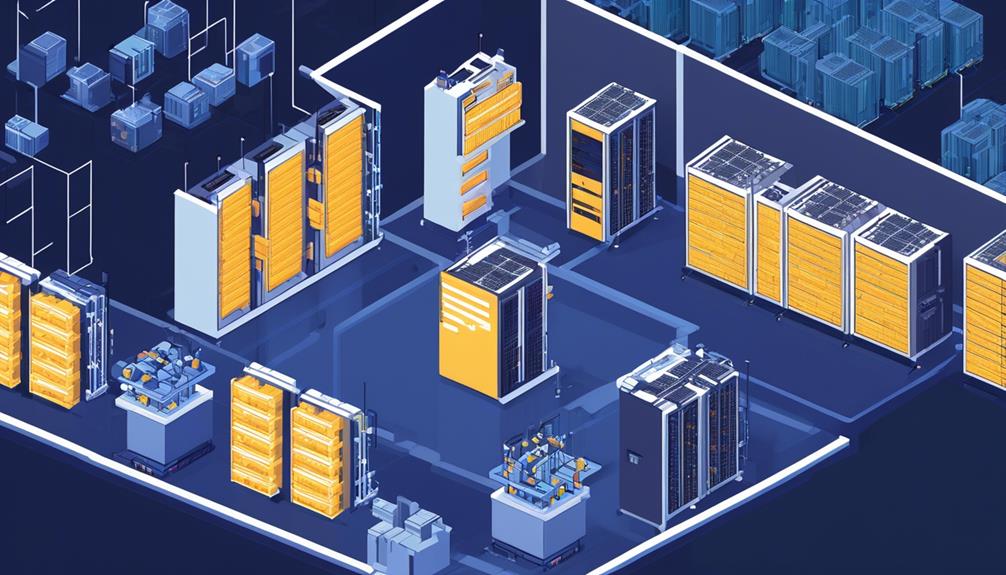
The scalability and flexibility of micro data centers make them a versatile solution for a wide range of edge computing applications. These small-scale data centers offer several advantages that contribute to their scalability and flexibility:
- Easily scalable: Micro data centers can easily scale up or down according to the computing and storage needs. This scalability allows businesses to adapt to evolving workloads and operational requirements without significant infrastructure changes. Whether there is a sudden increase in demand or a need to downsize, micro data centers can quickly accommodate these changes.
- Flexible deployment: Micro data centers offer flexibility in deployment, allowing for placement in a variety of environments and locations. They can be deployed in remote areas, branch offices, manufacturing facilities, or any other edge computing environment. This flexibility enables businesses to bring computing resources closer to the point of data generation, reducing latency and improving performance.
- Rapid deployment: Micro data centers can be quickly deployed to meet the demands of changing workloads and operational requirements. With their compact size and modular design, these data centers can be easily installed and commissioned in a short amount of time. This rapid deployment capability is particularly beneficial in scenarios where immediate computing resources are needed or when there is a need for temporary data processing capabilities.
The role of micro data centers in edge computing is crucial due to their scalability and flexibility. They provide businesses with the agility to adapt to evolving technological and operational needs without significant infrastructure changes. By offering easily scalable resources, flexible deployment options, and rapid deployment capabilities, micro data centers enable efficient edge computing solutions across various industries.
Edge Computing Use Cases for Micro Data Centers
Edge computing use cases for micro data centers offer numerous benefits. These include real-time processing for industries such as energy, manufacturing, retail, and healthcare. By placing micro data centers at the edge, faster response times and reduced latency can be achieved. This is particularly beneficial for applications like smart cities and IoT devices.
Furthermore, the integration of 5G technology further enhances the role of micro data centers in edge computing. It allows for the support of applications like precision agriculture and remote management in industrial environments.
Benefits of Micro Data Centers
Micro data centers offer numerous benefits in the context of edge computing, enabling organizations to optimize their network resources and overcome the limitations of cloud environments. Some of these benefits include:
- Faster Processing: With micro data centers located closer to the edge devices, data can be processed locally, reducing the latency caused by transmitting it to a central cloud server. This allows for faster response times and real-time processing of critical applications.
- Enhanced Reliability: By deploying micro data centers at the edge, organizations can avoid downtime caused by unstable network connections. This is particularly important in remote locations where disruptions in the cloud network can negatively impact businesses, such as retail stores.
- Improved Collaboration: Micro data centers support the growing demand for collaboration and work process reimagining in edge computing. By enabling data processing and storage at the edge, teams can work together more efficiently, sharing and accessing information in real-time.
These benefits make micro data centers a valuable component of edge computing, empowering organizations with faster processing, improved reliability, and enhanced collaboration capabilities.
Implementation Challenges of Edge Computing
What are the key implementation challenges faced when adopting edge computing with micro data centers? The implementation of edge computing with micro data centers presents unique challenges due to the high latency and bandwidth constraints. Meeting the specific edge computing requirements of diverse industries and applications is crucial. Security concerns and regulatory compliance must be carefully addressed when deploying edge computing through micro data centers. Scalability and flexibility are important factors to consider, as the needs of edge computing can vary across different environments. Additionally, the integration of edge computing with micro data centers requires meticulous planning and coordination to ensure seamless operations. The table below summarizes these challenges:
| Implementation Challenges of Edge Computing |
|---|
| High latency and bandwidth constraints |
| Meeting diverse industry requirements |
| Addressing security and regulatory concerns |
Integration of Micro Data Centers in IoT
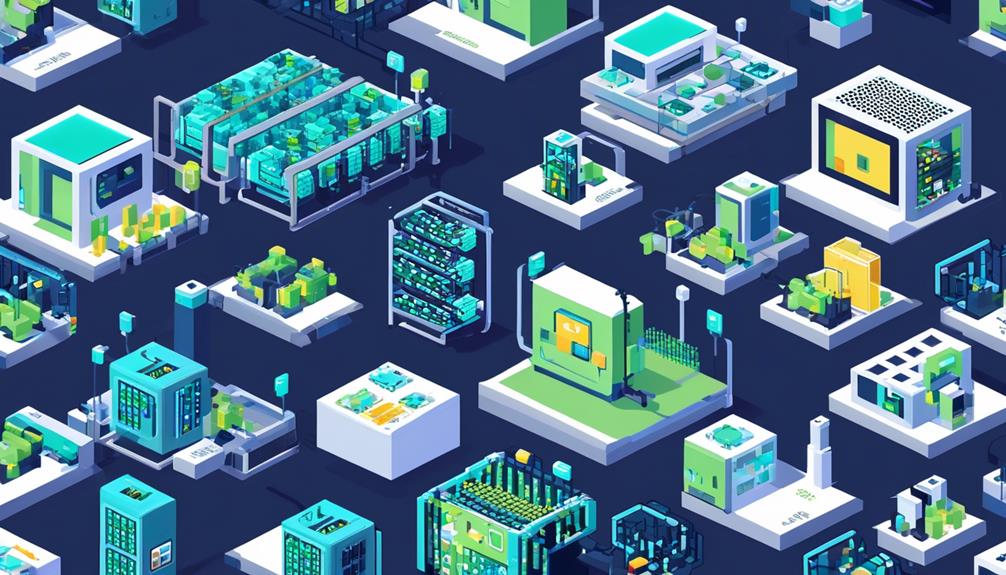
How does the integration of micro data centers in IoT enable real-time processing and analysis of data from distributed IoT devices?
The integration of micro data centers in IoT plays a crucial role in enabling real-time processing and analysis of data generated by distributed IoT devices. Here are three key ways in which this integration enables the efficient handling of IoT data:
- Reduced Latency: By integrating micro data centers at the edge of the network, the processing and storage of IoT-generated data can be performed closer to the source. This proximity ensures faster response times and reduced latency, which is critical for applications that require real-time data analysis and decision-making.
- Local Data Processing: Integration of micro data centers in IoT allows for local data processing, enabling IoT deployments to handle data closer to where it is generated. This reduces the need for transmitting large volumes of data across networks, leading to improved efficiency and reduced network congestion.
- Support for Machine-Generated Data: Micro data centers integrated with IoT infrastructure are designed to meet the processing requirements of machine-generated data from various IoT devices and sensors. These data centers can handle the high data volumes and processing demands of IoT applications, ensuring that real-time analytics and insights can be derived from the data.
Edge Computing and Micro Data Centers in Smart Cities
Smart cities are increasingly relying on edge computing and micro data centers to enhance their infrastructure and deliver efficient services.
With edge computing, data processing can happen closer to the source, reducing latency and improving response times for critical applications in smart cities.
Micro data centers play a crucial role in enabling edge computing by providing the necessary proximity and computing power.
Their deployment in smart cities ensures reliable and innovative solutions that address the unique needs of urban environments.
Smart City Infrastructure
Edge computing and micro data centers play a critical role in enhancing the infrastructure of smart cities by enabling real-time processing and reducing latency for applications such as IoT, 5G, and smart city services.
Here are three key ways in which they contribute to the development of smart city infrastructure:
- Edge data centers handle the massive influx of machine-generated data from IoT devices, smart cities, and 5G technology. They process and prepare this data for analysis, enabling faster and more efficient decision-making.
- Micro data centers are essential for the realization of 5G in smart cities, IoT, and drone delivery services. They provide localized computing and storage solutions, allowing for faster processing and reduced network traffic.
- Edge computing and micro data centers offer faster performance, lower latency, enhanced security, and reduced bandwidth costs for various industries, including energy, manufacturing, retail, healthcare, and transportation. These benefits drive digital transformation and enable the seamless integration of smart city services.
Edge Computing Benefits
In the realm of smart city infrastructure, the utilization of edge computing and micro data centers brings forth a multitude of benefits that enhance efficiency and enable real-time processing. Edge computing, by bringing data processing closer to the source, reduces latency and improves efficiency compared to traditional data centers. Micro data centers at the edge complement existing infrastructure, addressing connectivity issues and reducing the need to connect to hyperscale facilities. This enables faster response times by processing data closer to the end-user, overcoming the exponential increase in machine-generated data from IoT and 5G. Industries such as energy, manufacturing, retail, healthcare, and transportation greatly benefit from real-time processing, overcoming bandwidth limitations, and faster data processing enabled by edge computing and micro data centers.
| Edge Computing Benefits | ||
|---|---|---|
| Reduced Latency | Improved Efficiency | Real-time Processing |
| Complements Existing Infrastructure | Addresses Connectivity Issues | Faster Response Times |
| Overcomes Bandwidth Limitations | Enables Faster Data Processing | Benefits Various Industries |
Micro Data Center Deployment
Micro data center deployment plays a crucial role in the implementation of edge computing and the development of smart cities. These compact and versatile data centers complement existing infrastructure by offering computing and cooling power at the edge, closer to where data is generated.
Here are three key aspects of micro data center deployment:
- Improved Efficiency: Edge computing centers, such as micro data centers, bring data closer to the user, reducing latency and improving efficiency. This is particularly important in addressing the exponential increase in machine-generated data from IoT and 5G.
- Enhanced Security: By moving compute resources and storage closer to the source of data, businesses can enhance security. This approach minimizes the need for transmitting sensitive data to on-premise or cloud-based centralized data centers, reducing the risk of data breaches.
- Reduced Bandwidth and Latency Challenges: Industries across various sectors benefit from real-time processing and overcoming bandwidth limitations and latency challenges with edge computing and micro data centers. Energy, manufacturing, retail, telco, healthcare, gaming, and transportation industries can all leverage the power and proximity of micro data centers to process data more efficiently and deliver services to end-users with minimal delays.
Edge Computing Challenges and Solutions With Micro Data Centers
Addressing the challenges of edge computing, the implementation of micro data centers offers viable solutions to meet the high bandwidth and low latency requirements. These challenges include the need for real-time data processing and response time, which can be achieved by bringing data centers closer to the edge. Micro data centers at the edge provide proximity to enable edge computing, enhancing security, reducing bandwidth, and offering faster performance.
To further illustrate the challenges and solutions of edge computing with micro data centers, the following table outlines these key aspects:
| Challenges | Solutions |
|---|---|
| High bandwidth requirements | Micro data centers at the edge bring data closer to the user, reducing the need to connect to hyperscale facilities and improving efficiency. |
| Low latency requirements | By caching data and processing it locally, micro data centers at the edge can significantly reduce response time and improve overall user experience. |
| Connectivity issues | Parallel trends towards micro data centers at the edge complement the existing infrastructure, ensuring better connectivity and reducing network congestion. |
| 5G's real-time data transmission | The development of micro data centers at the edge is driven by the need for real-time data processing and transmission, which is essential for 5G networks. |
Edge Computing and Micro Data Centers in Healthcare
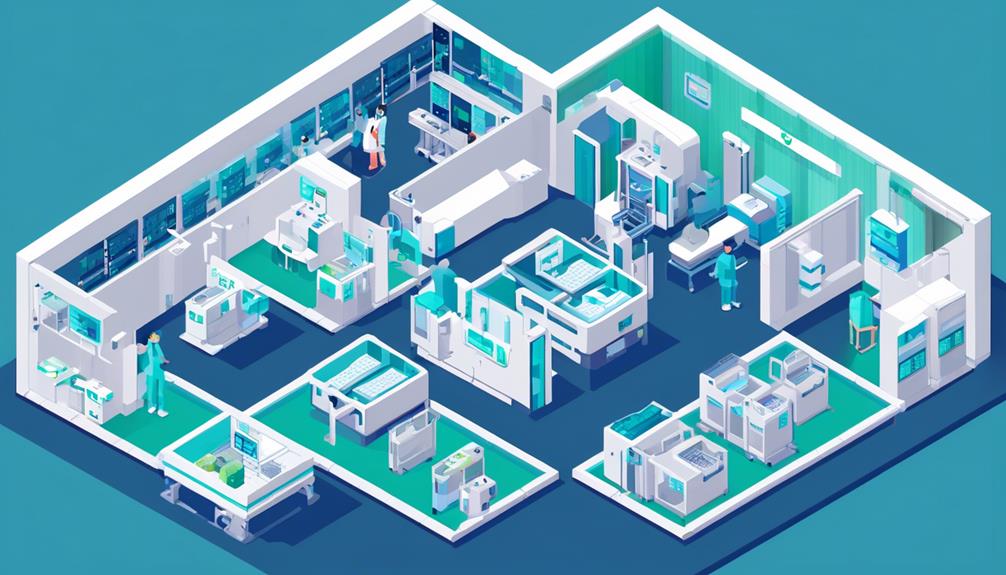
The integration of edge computing and micro data centers offers significant advantages in the healthcare industry, revolutionizing data processing and storage capabilities within healthcare settings.
Here are three key benefits of edge computing and micro data centers in healthcare:
- Enhanced Data Processing: Edge computing brings data processing closer to where it is generated, enabling healthcare providers to process and analyze data in real-time. With micro data centers strategically placed within healthcare facilities, sensitive data can be processed locally without the need to transmit it across networks. This reduces latency challenges and ensures that critical healthcare information can be processed and accessed quickly and efficiently.
- Improved Security: Healthcare organizations deal with a vast amount of sensitive data, including patient records and medical images. By deploying micro data centers within healthcare settings, organizations can enhance the security of their data. These data centers offer physical security measures and advanced encryption protocols to protect sensitive information, reducing the risk of data breaches and unauthorized access.
- Cost Savings: Edge computing and micro data centers in healthcare settings can lead to significant cost savings. By processing data locally, healthcare providers can reduce the need for transmitting large amounts of data across networks, resulting in lower bandwidth costs. Additionally, micro data centers offer a scalable and efficient solution that can minimize infrastructure costs. This enables healthcare organizations to allocate resources effectively and ensure consistent revenue generation.
Edge Computing and Micro Data Centers in Manufacturing
Edge computing and micro data centers play a pivotal role in revolutionizing data processing and storage capabilities within the manufacturing sector. With the advent of Industry 4.0 and the increasing number of Internet of Things (IoT) devices, manufacturing organizations are generating massive amounts of data.
Edge computing enables the processing of this data closer to the source, reducing latency and improving overall system performance.
Micro data centers in manufacturing allow businesses to move compute resources and storage closer to the point of data generation. By deploying these data centers at the edge of the network, manufacturers can overcome bandwidth limitations and latency challenges associated with traditional centralized data centers. Real-time processing of data becomes achievable, enabling faster decision-making and enhancing operational efficiency.
According to Gartner, by 2025, an estimated 75% of enterprise-generated data will be processed outside of the cloud or a traditional centralized data center. This emphasizes the critical role that micro data centers will play in the manufacturing industry. These data centers provide local data processing capabilities, reducing the need to transfer large volumes of data to a remote data center, which can be time-consuming and costly.
Furthermore, the integration of 5G technology in manufacturing relies heavily on edge computing and micro data centers. 5G networks require low latency and high bandwidth to support real-time applications like robotics and artificial intelligence. By deploying micro data centers closer to the devices, manufacturers can ensure seamless connectivity and enable the full potential of 5G technology.
Future Trends in Micro Data Centers for Edge Computing

As the demand for real-time data processing and low-latency applications continues to grow, the future of micro data centers for edge computing looks promising. These small-scale data centers are expected to play a crucial role in meeting the increasing need for edge computing power.
Here are three future trends in micro data centers for edge computing:
- Increased adoption in various industries: As more industries recognize the benefits of edge computing, the demand for micro data centers is expected to rise. Sectors such as manufacturing, healthcare, transportation, and retail are likely to invest in micro data centers to enable faster data processing and analysis at the edge. This adoption will lead to improved operational efficiency, enhanced decision-making, and better customer experiences.
- Integration with artificial intelligence (AI): Micro data centers will increasingly incorporate AI capabilities to enable intelligent edge computing. By leveraging AI algorithms at the edge, data can be analyzed and processed in real-time, allowing for faster insights and decision-making. This integration will enable autonomous systems, predictive maintenance, and real-time analytics, revolutionizing industries such as autonomous vehicles, smart cities, and IoT-enabled devices.
- Energy efficiency and sustainability: Future micro data centers will focus on energy efficiency and sustainability. These data centers will employ advanced cooling techniques, such as liquid cooling and natural ventilation, to minimize power consumption and reduce the environmental impact. Additionally, renewable energy sources, such as solar or wind, may be integrated to power these micro data centers, further reducing their carbon footprint.
Frequently Asked Questions
What Is Edge Micro Data Center?
An edge micro data center is a small-scale data center located closer to end-users or data sources. It is an essential component of the edge computing architecture, enabling edge data processing, storage, and network infrastructure.
What Is the Purpose of an Edge Data Center?
The purpose of an edge data center is to optimize latency and improve efficiency for end-users. These data centers play a crucial role in supporting IoT by bringing data processing closer to where it is generated. They also contribute to the development of autonomous vehicles by enabling real-time data transmission.
Security considerations are paramount in edge data centers to protect sensitive information.
Future trends and advancements in edge data centers include increased use in various industries and the integration of advanced technologies like AI and machine learning.
What Are the Benefits of Micro Data Centers?
Micro data centers offer numerous benefits to organizations. They provide cost savings by eliminating the need for large-scale data centers and reducing operational expenses. These compact units also offer scalability, allowing organizations to easily expand their computing capabilities as needed.
Micro data centers increase efficiency by enabling remote coordination and reducing travel expenses and wait time for technicians. Additionally, they enhance security by keeping data closer to the source and reduce latency by processing data locally, resulting in faster response times.
How Does Edge Computing Affect Data Center?
Edge computing has a significant impact on data center infrastructure. It introduces challenges in integrating edge computing with traditional data centers due to the need for distributed processing and storage.
Security considerations become crucial with data centers handling data closer to the source.
Scalability and flexibility are essential for data centers to support edge computing, as they need to accommodate varying workloads and dynamic resource allocation.
Future trends and advancements in edge computing will continue to shape data center design and operations.

